Sum of Consecutive Odd Integers Word Problems
If you know how to solve word problems involving the sum of consecutive even integers, you should be able to easily solve word problems that involve the sum of consecutive odd integers. The key is to have a good grasp of what odd integers are and how consecutive odd integers can be represented.
Odd Integers
If you recall, an even integer is always [latex]2[/latex] times a number. Thus, the general form of an even number is [latex]n=2k[/latex], where [latex]k[/latex] is an integer.
So what does it mean when we say that an integer is odd? Well, it means that it’s one less or one more than an even number. In other words, odd integers are one unit less or one unit more of an even number.
Therefore, the general form of an odd integer can be expressed as [latex]n[/latex] is [latex]n=2k-1[/latex] or [latex]n=2k+1[/latex], where [latex]k[/latex] is an integer.
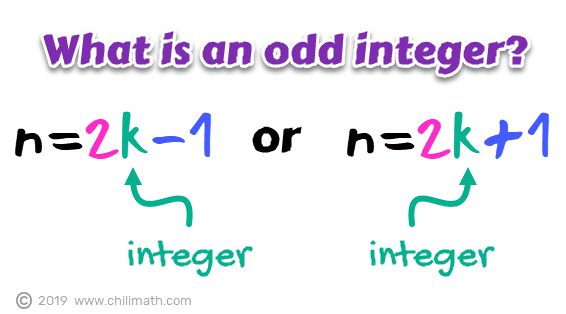
Observe that if you’re given an even integer, that even integer is always in between two odd integers. For instance, the even integer [latex]4[/latex] is between [latex]3[/latex] and [latex]5[/latex].
To illustrate this simple fact, take a look at the diagram below.
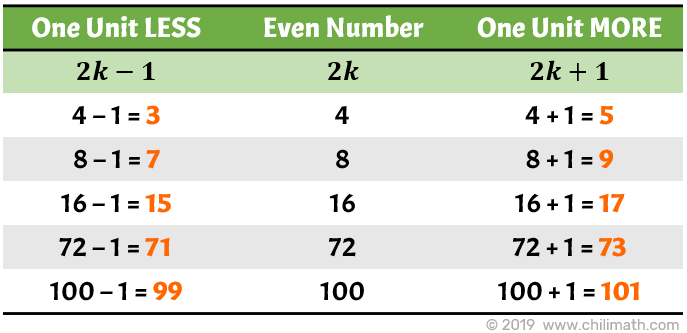
As you can see, no matter what even integer we have, it will always be in between two odd integers. This diagram also illustrates that an odd integer can be represented with either [latex]n=2k-1[/latex] or [latex]n=2k+1[/latex], where [latex]k[/latex] is an integer.
Consecutive Odd Integers
Consecutive odd integers are odd integers that follow each other in sequence. You may find it hard to believe, but just like even integers, a pair of any consecutive odd integers are also [latex]2[/latex] units apart. Simply put, if you select any odd integer from a set of consecutive odd integers, then subtract it by the previous one, their difference will be [latex]+2[/latex] or simply [latex]2[/latex].
Here are some examples:
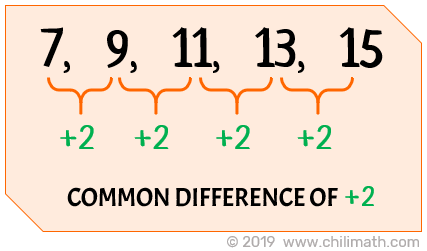
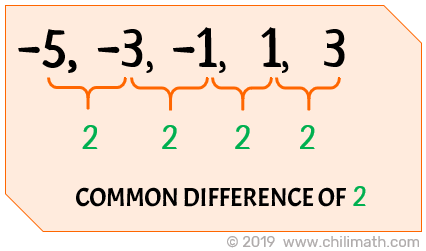
When solving word problems, it really doesn’t matter which general forms of an odd integer you use. Whether you use [latex]2k-1[/latex] or [latex]2k+1[/latex], the final solution will be the same.
To prove it to you, we will solve the first word problem in two ways. Then for the rest of the word problems, we will either use the form [latex]2k-1[/latex] or [latex]2k+1[/latex].
Examples of Solving the Sum of Consecutive Odd Integers
Example 1: Find the three consecutive odd integers whose sum is [latex]45[/latex].
METHOD 1
We will solve this word problem using [latex]2k+1[/latex] which is one of the general forms of an odd integer.
Let [latex]2k+1[/latex] be the first odd integer. Since odd integers are also [latex]2[/latex] units apart, the second consecutive odd integer will be [latex]2[/latex] more than the first. Therefore, [latex]\left( {2k + 1} \right) + \left( 2 \right) = 2k + 3[/latex] where [latex]2k + 3[/latex] is the second consecutive odd integer. The third odd integer will then be [latex]\left( {2k + 3} \right) + \left( 2 \right) = 2k + 5[/latex].
The sum of our three consecutive odd integers is [latex]45[/latex], so our equation setup will be:
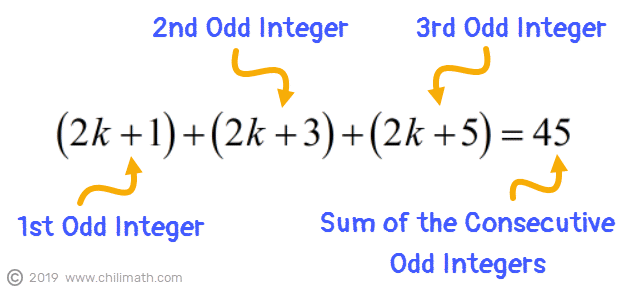
Now that we have our equation, let’s proceed and solve for [latex]k[/latex].
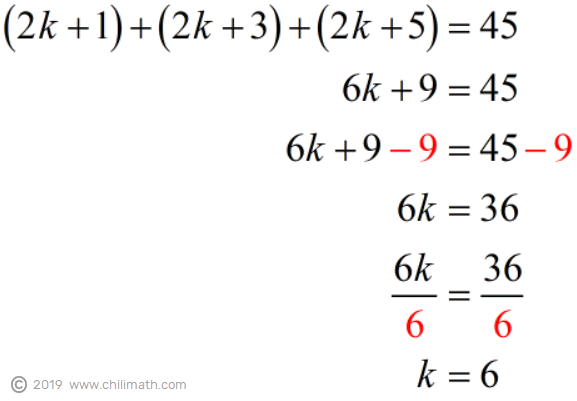
At this point, we have the value for [latex]k[/latex]. However, note that [latex]k[/latex] is NOT the first odd integer. If you review the equation above, the first consecutive odd integer is [latex]2k+1[/latex]. So instead, we will use the value of [latex]k[/latex] in order to find the first consecutive odd integer. Therefore,
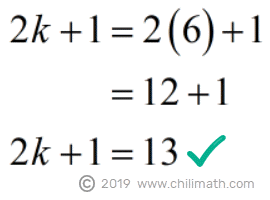
We’ll use the value of [latex]k[/latex] again to determine what the second and third odd integers are.
Second odd integer:
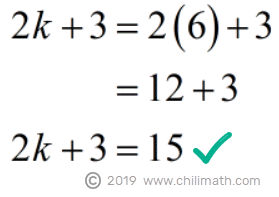
Third odd integer:
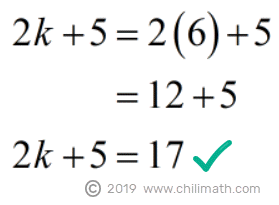
Finally, let’s check if the sum of the three consecutive odd integers is indeed [latex]45[/latex].

Final Answer (Method 1): The three consecutive odd integers are [latex]13[/latex], [latex]15[/latex], and [latex]17[/latex], which when added, results to [latex]45[/latex].
METHOD 2
This time, we will solve the word problem using [latex]2k-1[/latex] which is also one of the general forms of an odd integer.
Let [latex]2k-1[/latex] be the first consecutive odd integer. As discussed in Method 1, odd integers are also [latex]2[/latex] units apart. Thus, we can represent our second consecutive odd integer as [latex]\left( {2k – 1} \right) + \left( 2 \right) = 2k + 1[/latex] and the third consecutive odd integer as [latex]\left( {2k + 1} \right) + \left( 2 \right) = 2k + 3[/latex].
- 1st odd integer: [latex]2k-1[/latex]
- 2nd odd integer: [latex]2k+1[/latex]
- 3rd odd integer: [latex]2k+3[/latex]
Now that we know how to represent each consecutive odd integer, we simply have to translate “three consecutive odd integers whose sum is [latex]{45}[/latex]” into an equation.
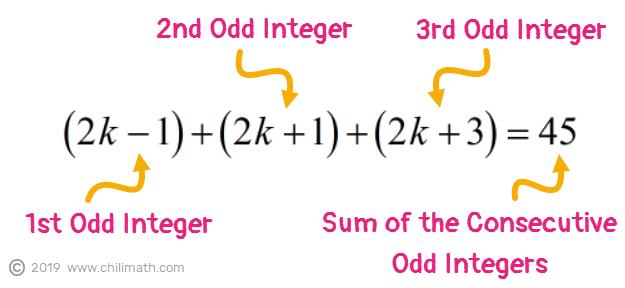
Proceed and solve for [latex]k[/latex].
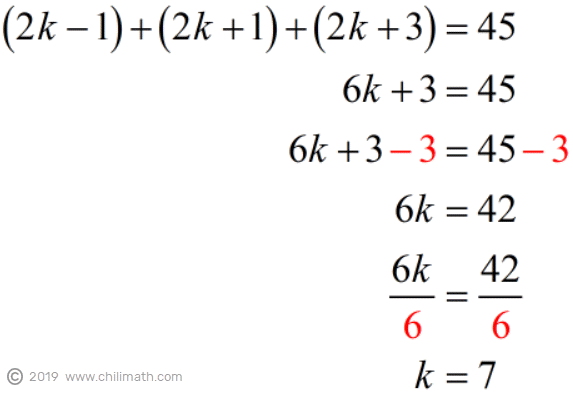
Let’s now use the value of [latex]k[/latex] which is [latex]k=7[/latex], to determine the three consecutive integers
- First odd integer:
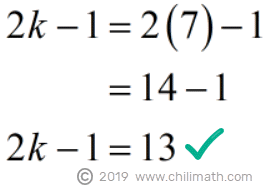
- Second odd integer:
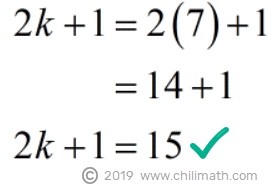
- Third odd integer:
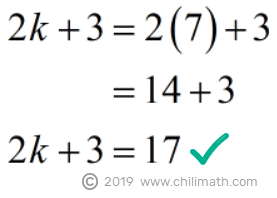
The last step for us to do is to verify that the sum of [latex]13[/latex], [latex]15[/latex], and [latex]17[/latex] is in fact, [latex]45[/latex].

Final Answer (Method 2): The three consecutive odd integers whose sum is [latex]45[/latex] are [latex]13[/latex], [latex]15[/latex], and [latex]17[/latex].
PROBLEM WRAP-UP: So what have we learned while solving this problem using [latex]2k-1[/latex] and [latex]2k+1[/latex]? Well, to start, we were able to see that whether we used [latex]2k-1[/latex] or [latex]2k+1[/latex], we still got the same three consecutive odd integers [latex]13[/latex], [latex]15[/latex], and [latex]17[/latex] whose sum is [latex]45[/latex], therefore satisfying the given facts in our original problem. So, it is clear that it doesn’t matter what general form of odd integers we use. Whether it’s [latex]2k-1[/latex] or [latex]2k+1[/latex], we will still arrive at the same final solution or answer.
Example 2: The sum of four consecutive odd integers is [latex]160[/latex]. Find the integers.
Before we start solving this problem, let’s determine the important facts that are given to us.
What do we know?
- The integers are odd and are consecutive
- The sum of the consecutive integers is [latex]160[/latex] which also implies that we need to add the integers
- The integers differ by [latex]{2}[/latex] units
- Each integer is [latex]{2}[/latex] more than the previous integer
With these facts in mind, we can now represent our four consecutive odd integers. But although we can use either of the two general forms of odd integers, i.e. [latex]2k-1[/latex] or [latex]2k+1[/latex], we’ll only use [latex]2k+1[/latex] to represent our first odd consecutive integer in this problem.
Let [latex]{2k+1}[/latex], [latex]{2k+3}[/latex], [latex]{2k+5}[/latex] , and [latex]{2k+7}[/latex] be the four consecutive odd integers.

Proceed by writing the equation then solve for [latex]k[/latex].
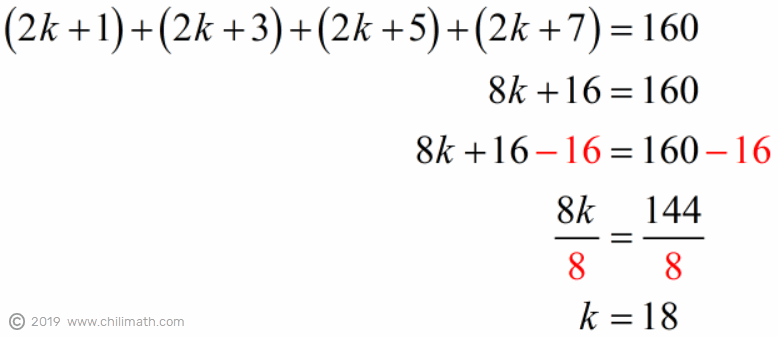
Alright, so we got [latex]k=18[/latex]. Is this our first odd integer? The answer is, no. Again, remember that [latex]k[/latex] is NOT the first odd integer. But instead, we’ll use its value to find what our consecutive odd integers are.
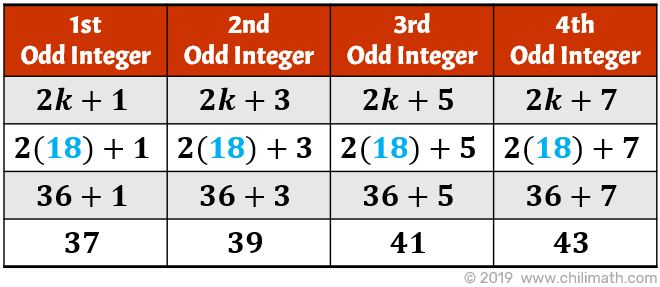
What’s left for us to do is to check if [latex]{160}[/latex] is indeed the sum of the consecutive odd integers [latex]{37}[/latex], [latex]{39}[/latex], [latex]{41}[/latex], and [latex]{43}[/latex].

Example 3: Find the three consecutive odd integers whose sum is [latex]-321[/latex].
Important Facts:
- We need to ADD three integers that are consecutive
- Since the integers are odd, they are [latex]{2}[/latex] units apart
- The sum of the three consecutive odd integers must be [latex]{-321}[/latex]
- The sequence of odd integers will more likely involve negative integers
Represent the three consecutive odd integers. For this problem, we will use the general form [latex]2k-1[/latex] to represent our first consecutive odd integer. And since odd integers are [latex]2[/latex] units apart, then we have [latex]2k+1[/latex] as our second, and [latex]2k+3[/latex] as our third consecutive integer.

Next, translate “three consecutive odd integers whose sum is [latex]{-321}[/latex]” into an equation and solve for [latex]k[/latex].
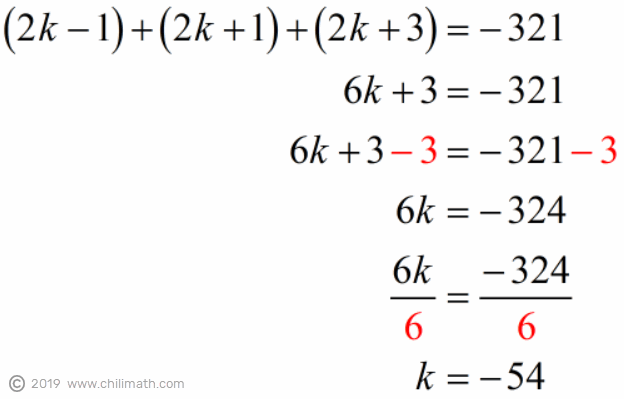
Take the value of [latex]k[/latex] which is [latex]-54[/latex] and use it to identify the three consecutive odd integers.
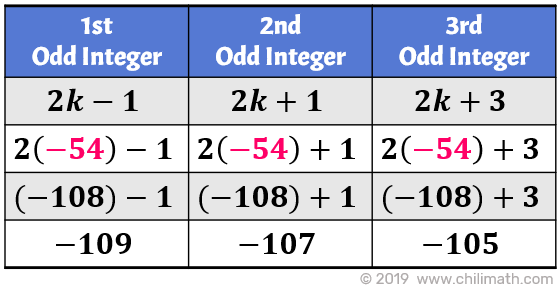
Finally, verify that when the three consecutive odd integers [latex]{-109}[/latex], [latex]{-107}[/latex] ,and [latex]{-105}[/latex] are added, the sum is [latex]-321[/latex].

You may also be interested in these related math lessons or tutorials:
Sum of Consecutive Integers Word Problems
